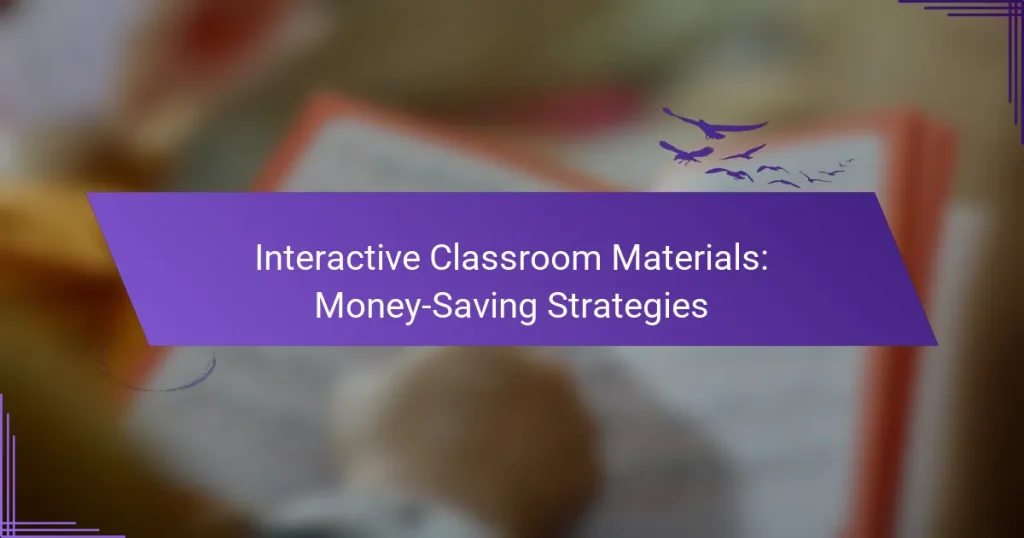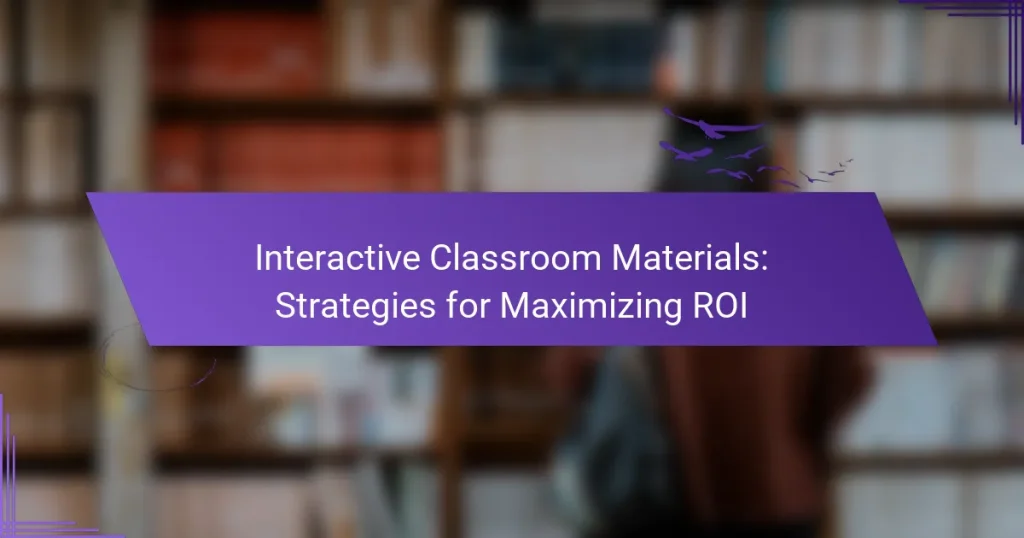Interactive classroom materials play a crucial role in enhancing cost-effectiveness by fostering active learning and minimizing traditional resource costs. These tools not only engage students more effectively but also contribute to improved retention and understanding, ultimately leading to significant savings in educational environments. By evaluating the financial impact and educational benefits of these materials, educators can make informed decisions that enhance learning outcomes while managing expenses.
Interactive Classroom Tools: Evaluating Cost-Effectiveness Metrics
Interactive Learning Investments: Cost-Benefit Analysis Factors
Interactive Classroom Materials: Budget-Friendly Options for Teachers
Interactive Classroom Materials: Affordable Resources for Nonprofits
Interactive Classroom Materials: Strategies for Maximizing ROI
How do interactive classroom materials enhance cost-effectiveness?
Interactive classroom materials enhance cost-effectiveness by promoting active learning and reducing traditional resource expenditures. By engaging students more effectively, these materials can lead to better retention and understanding, ultimately saving time and money in educational settings.
Increased student engagement
Interactive materials, such as digital simulations and gamified learning tools, captivate students’ attention and encourage participation. This heightened engagement often results in improved attendance and reduced dropout rates, which can save schools significant costs associated with student turnover.
For instance, using interactive quizzes can make assessments more enjoyable, leading to higher completion rates compared to standard tests. Schools can consider integrating platforms that allow real-time feedback, fostering a more dynamic learning environment.
Reduced resource expenses
By utilizing digital resources, schools can significantly cut down on physical materials like textbooks and printed handouts. Many interactive tools offer free or low-cost subscriptions, making them accessible while minimizing the need for costly printed resources.
Additionally, online platforms often provide a wealth of resources in one place, reducing the need for multiple purchases. Schools should evaluate free educational resources that align with their curriculum to maximize savings.
Improved learning outcomes
Interactive classroom materials can lead to better learning outcomes by catering to various learning styles and providing instant feedback. Research suggests that students who engage with interactive content often achieve higher test scores and demonstrate improved critical thinking skills.
For effective implementation, educators should track student progress using analytics provided by these tools. This data can help identify areas needing additional support, ensuring that resources are allocated efficiently to enhance overall educational effectiveness.
What are the best interactive classroom materials for online courses?
The best interactive classroom materials for online courses include tools that enhance engagement and facilitate collaboration among students. Options like Kahoot!, Nearpod, and Google Slides stand out for their effectiveness in creating dynamic learning experiences.
Kahoot! for quizzes
Kahoot! is a game-based learning platform that allows educators to create fun quizzes that students can answer in real-time. This tool is particularly effective for reinforcing knowledge and assessing understanding in an engaging way.
To use Kahoot!, teachers can design quizzes with multiple-choice questions and incorporate images or videos. Students join via a unique PIN and answer questions on their devices, making it easy to track participation and scores. Consider using Kahoot! for review sessions or as a quick assessment tool.
Nearpod for presentations
Nearpod is an interactive presentation tool that enables teachers to create engaging lessons with multimedia elements. It allows for real-time feedback and interaction, making it suitable for both synchronous and asynchronous learning environments.
With Nearpod, educators can integrate quizzes, polls, and open-ended questions into their presentations. This feature encourages student participation and provides immediate insights into their understanding. It’s ideal for lessons that require active engagement and can be adapted for various subjects and age groups.
Google Slides for collaboration
Google Slides is a versatile presentation tool that supports collaborative work among students. It allows multiple users to edit and contribute to presentations simultaneously, fostering teamwork and creativity.
Teachers can assign group projects using Google Slides, where students can work together in real-time from different locations. This tool is particularly useful for developing presentation skills and encouraging peer feedback. Ensure to set clear guidelines for collaboration to maximize effectiveness and engagement.
How can educators assess the cost-effectiveness of interactive materials?
Educators can assess the cost-effectiveness of interactive materials by analyzing their financial impact relative to the educational benefits they provide. This involves evaluating costs, measuring student outcomes, and gathering feedback to determine if the investment yields significant improvements in learning.
Cost-benefit analysis
A cost-benefit analysis involves comparing the total costs of implementing interactive materials against the educational gains achieved. Educators should consider both direct costs, such as purchasing software or hardware, and indirect costs, like training and maintenance. A simple formula to start with is: Total Benefits – Total Costs = Net Benefit.
For example, if an interactive tool costs $1,000 and leads to improved student engagement that can be quantified as a $3,000 increase in educational outcomes, the net benefit would be $2,000. This analysis helps prioritize which materials to invest in based on their return on investment.
Student performance metrics
Measuring student performance metrics is crucial for evaluating the effectiveness of interactive materials. Metrics may include test scores, completion rates, and engagement levels. Tracking these metrics before and after the implementation of new materials can provide clear insights into their impact on learning.
For instance, if a class using interactive materials shows a 15% increase in test scores compared to a control group, this suggests that the materials are positively influencing student performance. Regular assessments can help educators make informed decisions about continuing or adjusting their use of these resources.
Feedback surveys
Feedback surveys are an effective way to gather qualitative data on the perceived value of interactive materials from both students and teachers. Surveys can include questions about usability, engagement, and overall satisfaction. This information can highlight strengths and weaknesses in the materials being used.
For example, if 80% of students report that an interactive tool makes learning more enjoyable, it indicates a positive reception. However, if many users cite technical difficulties, this feedback can guide necessary improvements or adjustments to enhance the learning experience.
What factors influence the cost of interactive classroom materials?
The cost of interactive classroom materials is influenced by several key factors, including licensing fees, training requirements, and technology infrastructure. Understanding these elements can help educators and administrators make informed decisions about budgeting and resource allocation.
Licensing fees
Licensing fees are often a significant component of the overall cost of interactive classroom materials. These fees can vary widely based on the type of software or platform being used, ranging from a few hundred to several thousand dollars annually. It’s essential to consider whether the license is a one-time purchase or requires ongoing payments.
When evaluating licensing options, look for discounts for bulk purchases or educational institutions. Some providers may also offer tiered pricing based on the number of users, which can help manage costs effectively.
Training requirements
Training requirements can add to the total expense of implementing interactive classroom materials. Effective training ensures that educators are comfortable using new tools, which can lead to better student engagement and learning outcomes. Costs for training can range from free online resources to several hundred dollars for comprehensive workshops.
Consider investing in training sessions that are tailored to your specific materials and teaching environment. Peer-led training or collaborative learning sessions can also reduce costs while fostering a supportive community among educators.
Technology infrastructure
The existing technology infrastructure in a school or district plays a crucial role in determining the cost of interactive classroom materials. Schools may need to invest in hardware upgrades, such as tablets or interactive whiteboards, which can range from a few hundred to several thousand dollars depending on the scale of implementation.
Before purchasing interactive materials, assess the current technology capabilities and identify any gaps. Ensuring that the necessary infrastructure is in place can prevent unexpected expenses and facilitate a smoother integration of new tools into the classroom.
What are the prerequisites for implementing interactive materials?
Implementing interactive materials in the classroom requires several key prerequisites, including effective teacher training, access to appropriate technology, and alignment with the curriculum. These factors ensure that educators can utilize interactive tools effectively to enhance student engagement and learning outcomes.
Teacher training programs
Teacher training programs are essential for equipping educators with the skills needed to integrate interactive materials into their teaching. These programs should focus on both the technical aspects of using technology and pedagogical strategies that leverage interactive tools for effective learning.
Training can take various forms, such as workshops, online courses, or peer mentoring. Schools should consider ongoing professional development to keep teachers updated on the latest interactive technologies and teaching methodologies.
Access to technology
Access to technology is a critical factor in the successful implementation of interactive materials. Schools need to ensure that both teachers and students have reliable access to devices such as tablets, laptops, or interactive whiteboards, as well as a stable internet connection.
Budget constraints can affect technology access, so schools should explore funding options, such as grants or partnerships with tech companies, to provide the necessary resources. Additionally, maintaining and updating technology is crucial to avoid disruptions in learning.
Curriculum alignment
Curriculum alignment ensures that interactive materials complement and enhance existing educational goals and standards. Schools should evaluate how these materials fit within the current curriculum and make adjustments as necessary to maximize their effectiveness.
When selecting interactive tools, educators should consider how they support learning objectives and assessment methods. This alignment helps in creating a cohesive learning experience that engages students while meeting educational requirements.
How do interactive materials compare to traditional resources?
Interactive materials often provide a more engaging and effective learning experience compared to traditional resources. They utilize technology to foster participation, enhance understanding, and cater to diverse learning styles.
Engagement levels
Interactive materials typically lead to higher engagement levels among students compared to traditional textbooks or lectures. Tools like educational games, simulations, and interactive quizzes encourage active participation, making learning more dynamic.
For example, a classroom using interactive whiteboards can facilitate group discussions and real-time feedback, which can significantly increase student involvement. In contrast, traditional methods may lead to passive learning, where students are less likely to participate actively.
To maximize engagement, educators should integrate various interactive tools that align with their curriculum. This could include online platforms that allow for collaborative projects or virtual reality experiences that immerse students in the subject matter.





